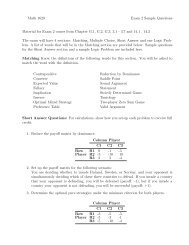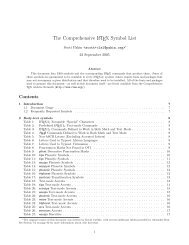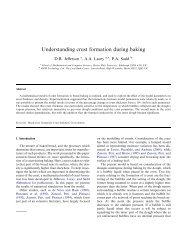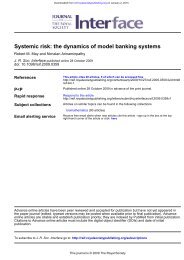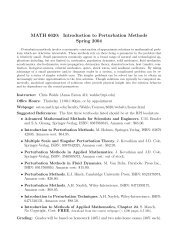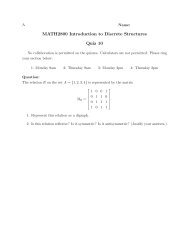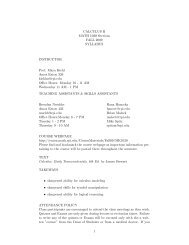On converging shock waves of spherical and polyhedral form
On converging shock waves of spherical and polyhedral form
On converging shock waves of spherical and polyhedral form
Create successful ePaper yourself
Turn your PDF publications into a flip-book with our unique Google optimized e-Paper software.
374 D. W. Schwendeman<br />
computed from the edge values for α by solving the linear equations<br />
h p · (v 0 e v + w 0 e w ) = ˜α kp − ˜α k1 , p = 2 <strong>and</strong> 3,<br />
where h p is the vector from the edge centre k 1 to the edge centre k p , <strong>and</strong> e v <strong>and</strong> e w<br />
are unit vectors in the tangent plane <strong>of</strong> the surface corresponding to the (orthogonal)<br />
directions <strong>of</strong> the components v 0 <strong>and</strong> w 0 , respectively. The definitions <strong>of</strong> ˜F j0 <strong>and</strong> M 0<br />
provide nonlinear equations for u 0 :<br />
˜F j0 =<br />
(<br />
M0<br />
A(M 0 )<br />
)<br />
u 0 , M 0 = (u 2 0 + v 2 0 + w 2 0) −1/2 ,<br />
but these equations are not solvable for all choices <strong>of</strong> v 0 , w 0 , <strong>and</strong> ˜F j0 . For the<br />
area–Mach number relation (2.3), solutions exist for<br />
[ ] −n/2 ( )<br />
1 n + 1<br />
v<br />
˜F j0 < √<br />
n + 1 n (v2 0 + w0)<br />
2 2<br />
<strong>and</strong> u 0 > 0 + w0<br />
2 1/2<br />
. (3.4)<br />
n<br />
The latter inequality is equivalent to the geometric constraint that the characteristic<br />
cone about ∇α cannot become tangent to the grid surface S h (η). This limits the<br />
angle between the <strong>shock</strong> surfaces α(x) = a 0 t as determined by a solution <strong>of</strong> (3.1)<br />
<strong>and</strong> the chosen family <strong>of</strong> surfaces S(η) for the numerical method. This constraint is<br />
analogous to the one discussed previously in Schwendeman (1999). The implication<br />
<strong>of</strong> the constraint for the problems <strong>of</strong> interest for this paper will be discussed in § 4.<br />
3.2. The Riemann problem for geometrical <strong>shock</strong> dynamics<br />
A Riemann problem is solved numerically in the neighbourhood <strong>of</strong> each face <strong>of</strong> the<br />
prism elements in order to obtain approximations for ˜G k <strong>and</strong> ũ k needed in (3.2) <strong>and</strong><br />
(3.3) to advance ˜F j <strong>and</strong> ˜α k , respectively, on the grid. This approach is similar to the one<br />
used in Schwendeman (1999) for two-dimensional <strong>shock</strong> propagation. For geometrical<br />
<strong>shock</strong> dynamics, a suitable Riemann problem for a system <strong>of</strong> first-order hyperbolic<br />
partial differential equations, equivalent to the second-order scalar equation for α in<br />
(3.1), may be introduced <strong>and</strong> solved for the components <strong>of</strong> ∇α. The solution consists<br />
<strong>of</strong> intervals <strong>of</strong> constant ∇α separated by <strong>shock</strong>-<strong>shock</strong>s or <strong>shock</strong>-expansions. (The<br />
term ‘<strong>shock</strong>-expansion’ used in the present discussion refers to smooth, expansiontype<br />
solutions <strong>of</strong> the equations.) For the two-dimensional case, <strong>form</strong>ulas for these<br />
transitions are available in Whitham (1974). The analogous <strong>form</strong>ulas for the threedimensional<br />
case are new <strong>and</strong> are discussed below. A method <strong>of</strong> iteration involving<br />
the <strong>form</strong>ulas for <strong>shock</strong>-<strong>shock</strong>s <strong>and</strong> <strong>shock</strong>-expansions is used to solve the Riemann<br />
problem numerically <strong>and</strong> determine values for ˜G k <strong>and</strong> ũ k .<br />
Let us consider an orthogonal coordinate system (x, y, z) in the neighbourhood <strong>of</strong><br />
a prism face, where x measures distance along the face in the direction <strong>of</strong> increasing<br />
η, y measures distance normal to the face, <strong>and</strong> z measures distance along the face<br />
in the cross-flow direction (perpendicular to the x-direction). Suppose further that<br />
u = (u, v, w) are the components <strong>of</strong> ∇α in the (x, y, z) directions, respectively. In this<br />
local system, the governing equations (3.1) become<br />
∂<br />
∂x<br />
( M<br />
A(M) u )<br />
+ ∂<br />
∂y<br />
( M<br />
A(M) v )<br />
+ ∂ ∂z<br />
<strong>and</strong> M = (u 2 + v 2 + w 2 ) −1/2 , together with the identities<br />
∂v<br />
∂x − ∂u<br />
∂y = 0,<br />
( M<br />
A(M) w )<br />
= 0, (3.5)<br />
∂w<br />
∂x − ∂u = 0. (3.6)<br />
∂z



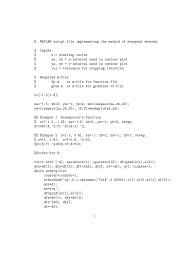

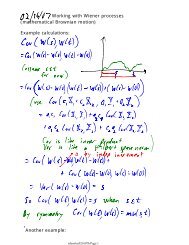

![MATH 1500 Sample Questions Exam 2 1. [3.7] A 10-ft plank is ...](https://img.yumpu.com/43861920/1/190x245/math-1500-sample-questions-exam-2-1-37-a-10-ft-plank-is-.jpg?quality=85)
